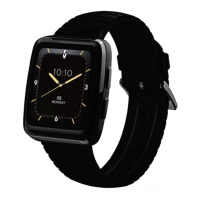Masmio W1 General Warnings and Precautions
Masimo Corporation 6 www.masimo.com
Cleaning and Service Warnings
WARNING: The following can cause damage that may impact the performance of your Masimo W1:
• Do not attempt to sanitize or sterilize using heat, steam, boiling or similar means.
• Clean only with the solutions listed in this manual.
WARNING: Do not attempt to remanufacture, recondition, or recycle the Masimo W1 as these processes may damage the electrical components, potentially leading to user
harm.
CAUTION: Only perform maintenance procedures specifically described in the manual. Otherwise, return the Masimo W1 for servicing.
CAUTION: To avoid permanent damage to the Masimo W1, do not use undiluted bleach (5% - 5.25% sodium hypochlorite) or any other cleaning solution not recommended.
Compliance Warnings
WARNING: Changes or modifications not expressly approved can void the user’s authority to operate the equipment.
WARNING: The frequency bands of this device (2.4 GHz and 5.15 to 5.25 GHz) are only for indoor use, in accordance with international telecommunication requirements.
WARNING: Do not incinerate the Masimo W1. The device contains a battery that should be properly disposed according to local laws and regulations.
WARNING: To help mitigate cybersecurity concerns, consider the following:
• Deactivating the Masimo W1 Bluetooth when not compatible or uncertain of the security of the Bluetooth connection.
• Do not wireless connect Masimo W1 with software not authorized for use by Masimo.
• Check the paired connection is made with the correct decision.
• Connect the Masimo W1 to a Masimo smart device application so that data can be stored and kept.
CAUTION: Comply with local laws in the disposal of the device.
CAUTION: Keep Masimo W1 away from electrical equipment that emits radio frequencies to minimize radio interference. Radio interference may result in no or inaccurate
readings.
Note: This equipment has been tested and found to comply with the Class B limits in accordance with EN 60601-1-2: 2015. These limits are designed to provide reasonable
protection against harmful interference in all establishments, including domestic establishments.
Note: This device complies with part 15 of the FCC Rules. Operation is subject to the following two conditions: (1) This device may not cause harmful interference, and (2)
this device must accept any interference received, including interference that may cause undesired operation.
Note: Masimo W1 and Masimo W1 Wireless Charger are exempt from FCC and IC RSS 102 RF radiation exposure testing requirements set forth for an uncontrolled
environment.
Note: When using Masimo W1 and consideration should be taken to local government frequency allocations and technical parameters to minimize the possibility of
interference to/from other wireless devices.
Note: This equipment has been tested and found to comply with the limits for a Class B digital device, pursuant to part 15 of the FCC Rules. These limits are designed to
provide reasonable protection against harmful interference in a residential installation. This equipment generates, uses, and can radiate radio frequency energy and, if not
installed and used in accordance with the instructions, may cause harmful interference to radio communications. However, there is no guarantee that interference will not
occur in a particular installation. If this equipment does cause harmful interference to radio or television reception, which can be determined by turning the equipment off and
on, the user is encouraged to try to correct the interference by one or more of the following measures:
• Reorient or relocate the receiving antenna.
• Increase the separation between the equipment and receiver.
• Connect the equipment into an outlet on a circuit different from that to which the receiver is connected.
• Consult the dealer or an experienced radio/TV technician for help.
Note: This device complies with Industry Canada license-exempt RSS standard(s). Operation is subject to the following two conditions: (1) this device may not cause
interference, and (2) this device must accept any interference, including interference that may cause undesired operation of the device.

